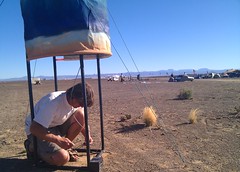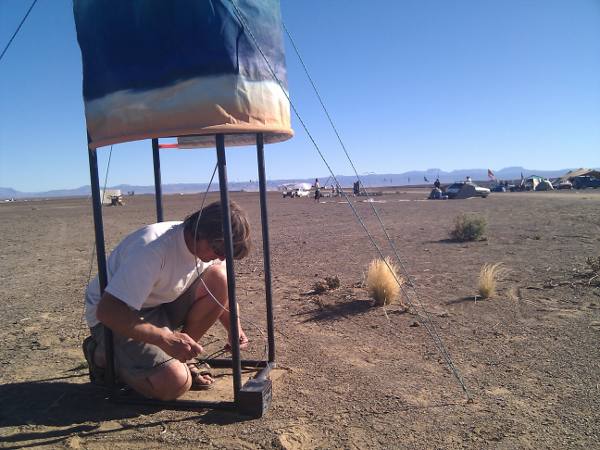 We headed for Tankwa Town with a full load and empty wallet and flashed & configured the Mesh Potatoes (MPs) in the desert using the good ol’ 192.168 range. The booths were different to last year: they had production MPs, new sleeves and no lighting. I set each node with a different Virtual Access Point (VAP) SSID based on the phone number because I found that using an identical VAP SSID caused SSH to die. This will be ideal in the future, when each MP owner has a WPA key on their router and both cabled and VAP connections are linked to the same account. So any device that wants to roam must either switch between VAPs or run batman itself.
We headed for Tankwa Town with a full load and empty wallet and flashed & configured the Mesh Potatoes (MPs) in the desert using the good ol’ 192.168 range. The booths were different to last year: they had production MPs, new sleeves and no lighting. I set each node with a different Virtual Access Point (VAP) SSID based on the phone number because I found that using an identical VAP SSID caused SSH to die. This will be ideal in the future, when each MP owner has a WPA key on their router and both cabled and VAP connections are linked to the same account. So any device that wants to roam must either switch between VAPs or run batman itself.
Steve came up for 2 days to help set up and bring some much-needed supplies. I discovered that an Olmeca tequila bottle is not as sturdy as it looks. It broke in the trailer and softened up the Tetrapak milk until most of the cartons ruptured too. So a Nano, a few phones and other gear were swamped. Thanks for the rescue, Steve.
We set up the booths easily this year – far less wiring and better ground pegs. We put phones in the organiser’s caravan, medics and the gate, with a Nano to cover the 5km distance to the gate. However this year they had moved the gate to the end of the airstrip, so it was only 1km away.
I had brought a netbook with broken screen to act as gateway, redirecting all port 80 traffic to a phpbb3 bulletin board with the appropriate DirtyBoard2.0 skin – see http://swug.za.net/phpbb/. I also redirected port 53 to dnsmasq that spoofed the DNS of Top Level Domains (TLDs) to the gateway IP too. These are the kinds of things that naughty people do, but I think it works well for our application. I set each router’s dns as 8.8.8.8 and SIP registration to villagetelco.org. When a mesh is connected to the Internet, DNS & SIP will work fine (once VT has a SIP server). If there is no Internet access, DNS/SIP/HTTP can be fielded by an offline gateway server. It does look a bit odd, but it works.
The spoof gateway was running fine for devices connected to the LAN but was not accessible from the WAN. In fact, no other device connected to a different MP could be seen except for the MP’s LAN address itself. This suggested that there was an issue with the dummy gateway setting on the LAN, required to allow Asterisk to run as per David & Elektra’s discussion
I was 4 days into the trip by then and it was time to party, so I left the gateway for another day – and Internet access. It was most helpful though in checking the booths. Instead of plugging in a netbook, one could just pick a nearby cosy camp, settle down and connect wirelessly. DHCP, LAN bridging, batman routing, Asterisk were all working fine.
Solar operation
This year I invested in a 90W monocrystalline solar panel and regulator for the camp – 90 watts when the sun is shining for the next 25-50 years. It will be part of my home solar office in a few weeks. I had 4 105AH tractor batteries from last year and connected the gateway netbook and the fixed one (20-40W each), plus about 20W of lighting and didn’t have a power problem for the whole week.
We used the 10W flexible solar panels and 12AH batteries on the booths as with last year, but this time there was no lighting in the booths. 10W kept the booth MPs up throughout the week, but the batteries drained progressively. I put this down to the number of phone calls being made – nearly all the time, day & night. One booth’s phone was left off-hook providing dialtone for a few hours. I disconnected it for a charge back at camp and it was sorted. Perhaps a dialtone hangup can be written into Asterisk for such events on battery-powered phones.
I also installed a phone in a friend’s art car, connected to the cigarette lighter adapter. It was great to be able to phone the art car from anywhere and ask for a pick-up. However next year, I’ll bring along some battery clips so that the phone stays on when the car is off – see whether the MP can “survive the crank”.
Conclusion
 This year was tougher with just Steve and I setting up, but easier because of the work we could build on from last year. The most promising result from this year were that the phones worked and worked hard. It gave me some time to work towards the 4093-node, no-NAT VAP firmware I long for. Although the VAP was not feeding into the gateway, every person with a wifi-enabled laptop or phone saw hotspots – so hopefully they’ll be better prepared next time too. Comments from participants were different this year too. Last year the phones were a novelty; this year people were more interested in and supportive of the technology behind the phones.
This year was tougher with just Steve and I setting up, but easier because of the work we could build on from last year. The most promising result from this year were that the phones worked and worked hard. It gave me some time to work towards the 4093-node, no-NAT VAP firmware I long for. Although the VAP was not feeding into the gateway, every person with a wifi-enabled laptop or phone saw hotspots – so hopefully they’ll be better prepared next time too. Comments from participants were different this year too. Last year the phones were a novelty; this year people were more interested in and supportive of the technology behind the phones.
This year I met some important people for next year. Adriaan Wessels is the technical chap on the organising committee. For next year, we’ll be able to plan carefully regarding gate link and possibly organiser car links. Organiser confidence in the network will mean that they will be able to pre-announce a “Tankwanet” and its services so that participants can be better prepared to take advantage. There are a lot of IT geeks at Afrikaburn. Perhaps some of them could be persuaded to offer services on the network.
Rod Bracher runs the Tankwa Town post office, Burning Mail. They have some old rotary-dialling phones that they connect with carrier but without dialling. I tried to coordinate with him to hook his phones up to the network, but ran out of time. We had a chat about doing so at this burn, so pulse-dialling is definitely on for next year.
The streaming services company antfarm.co.za were at AfrikaBurn this year. I couldn’t spot their VSAT dish, but made brief contact. They were streaming the burns live, which led me to figure a rule at AfrikaBurn: the isolation is an important part of the event, but the isolation need only exist one way – incoming. So theoretically, participants should be able to send SMSs, update their twitter accounts and post on a forum on the Internet – as long as they don’t see any response from outside the burn. Antfarm’s ISP only allows Internet connection on port 80, so a little port jiggling and a helpful Internet server should squeeze whatever we need through, except for multiport SIP.
Lastly and simply, Isigidimi was at AB2011. The continuity will help us attract more participants next year, and perhaps more of the VT-dev community. You can set up an Asterisk service, website, jabberd, tinker with pulse-dialling, or just sip on the Kool Aid and be inspired ;^)
Here are some more images from Afrikaburn 2011
